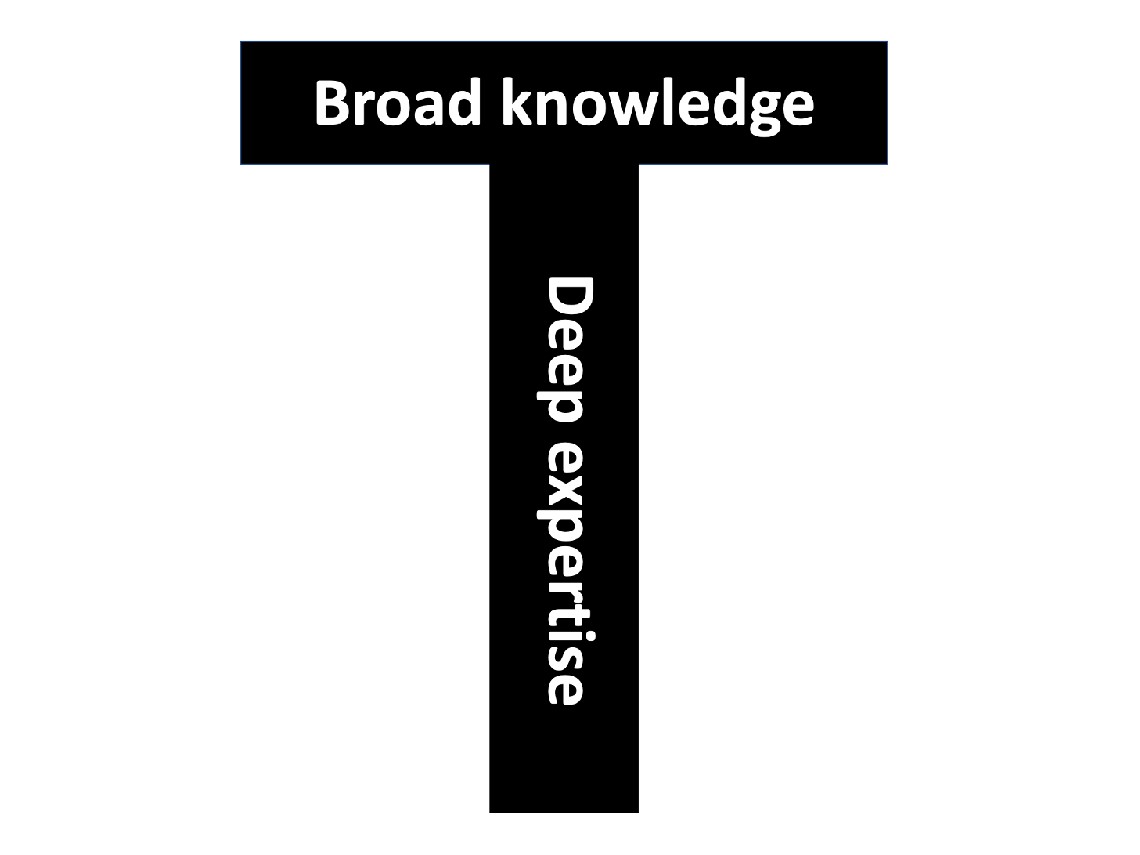The Power of T Thinking in Teamwork

The concept of teamwork has been with us throughout evolution. For example, our ancestors formed tribes to hunt and gather food together. When defending ourselves, having safety in numbers increased our chances of survival. Over centuries our communities have grown from agriculturally based neighbourhoods into the complex and interdependent societies that we have today. Whatever the size of our organisation, our workplaces rely on teamwork. So, what does it take to be an effective team player?
The focus on teamwork in the workplace often highlights the importance of interpersonal skills. Attributes such as having emotional intelligence, listening to and understanding each others’ points of view lead to team members being able to trust each other. These are the sorts of skills we advocate to improve team working. These are all extremely valid.
But we know that work is not just about skills. Knowledge is required too. Knowledge can be about different products, services and processes or specific areas such as finance, marketing and human resources.
So as organisations grow and develop, to what level is knowledge needed across an organisation to avoid silo thinking? This question takes on even greater significance as organisations grow and split into different functional teams.
The concept of T thinking provides a solution. First accredited to consulting firm McKinsey & Company a number of decades ago, the visualisation of the capital letter T works well to help describe the breadth and depth of knowledge needed to demonstrate teamwork at either a personal, team or organisational level.
Here’s how it works:
- Picture the capital letter T.
- The horizontal bar of the T refers to the breadth of the team e.g. the many functions that the team or organisation performs. Having necessary knowledge is important so that team members understand how the various components of the team fit together. In simple terms, the much bigger, broader picture is understood.
- The vertical column of the T represents the depth of knowledge that an individual member of the team has. This leads to team members becoming subject matter experts, being able to develop sophisticated strategies and processes and have the capability to handle complex queries and problems.
Adopting the concept of T thinking works on many different levels. Here are some examples:
- Sales: To properly engage with potential customers, sales teams need to be able to understand the full range of products and services their company offers. Only then can they properly cross-sell and up-sell to fully meet their customers needs. They may need to defer to subject matter experts at some point but having the broad range of products and services on offer will help inspire confidence within themselves as well as their customers.
- Customer service: Handling enquiries efficiently and effectively needs a broad knowledge of how a company works. This will avoid unnecessary and clumsy handovers to colleagues elsewhere in the organisation. Referring customers on to subject matter experts in a way that builds confidence can help turn a potential negative experience into something far more enriching.
- Manufacturing processes: Understanding the bigger picture helps promote teamwork. Thinking in a T way will help prevent unintended consequences from happening by avoiding the risk of thinking and acting in silos. Involving relevant subject matter experts promotes a culture of collaboration between individuals and teams rather than unhealthy and damaging competition
The opposite of T thinking is I thinking. Imagine the letter I. Although this represents deep expertise in a particular area it also shows a narrow view of the organisation. In other words this promotes the danger of silo thinking, risking poor customer service, inefficiency, unwarranted conflict and poor teamwork.
In summary, T thinking elevates teamwork to a much higher level. Our advice is to introduce T thinking into your own team meetings when discussing problems and issues that arise. Offer T thinking so the bigger picture is considered alongside the expert views that are so important. Also, use T thinking with your own team members at their 1:1 meetings by asking them how they can widen their broader knowledge and deepen their expertise. Finally, ask yourself on which areas of the T you need to focus so that your own development is not ignored or forgotten.
Paul Beesley
Director and senior consultant, Beyond Theory

